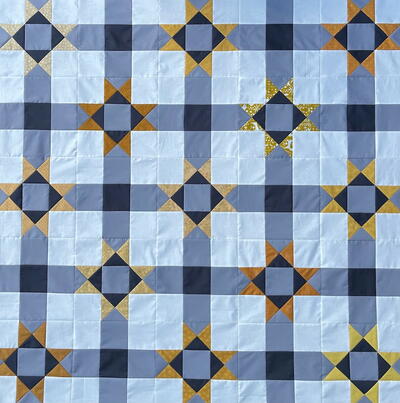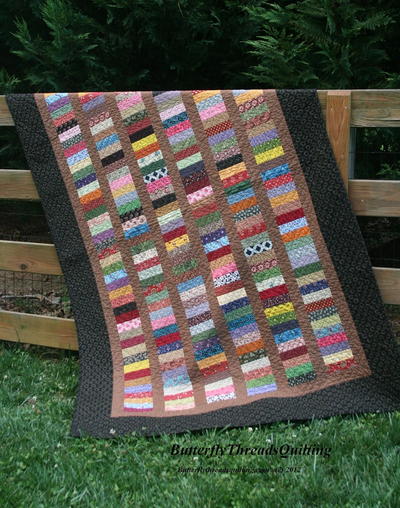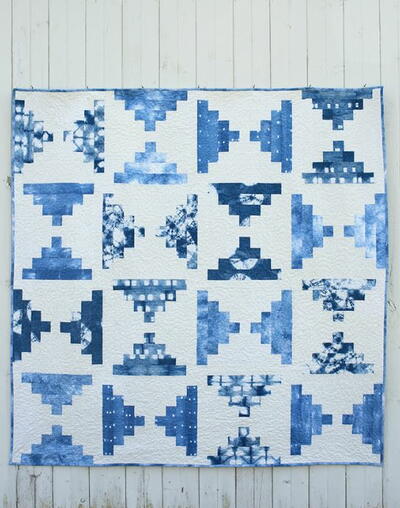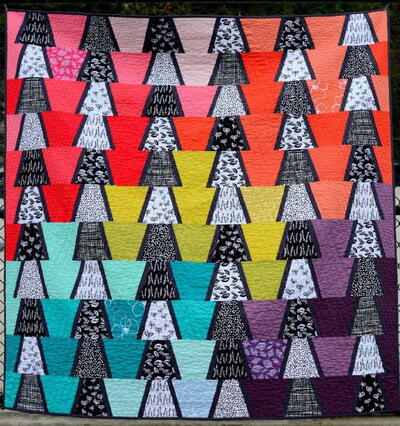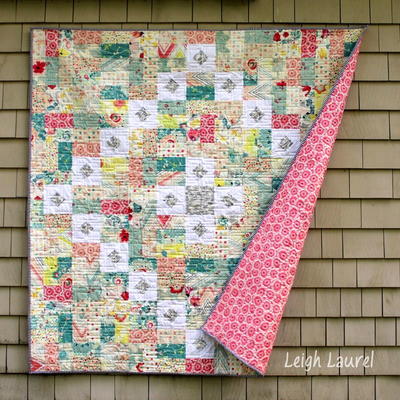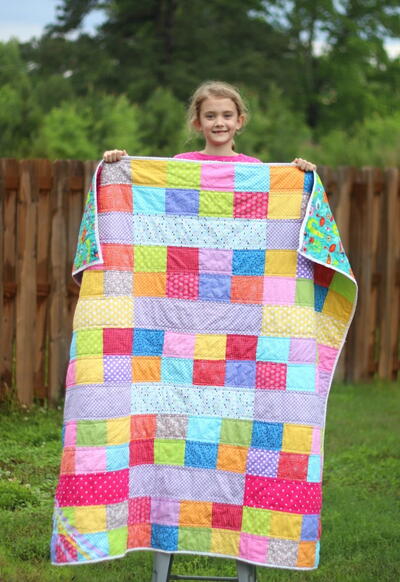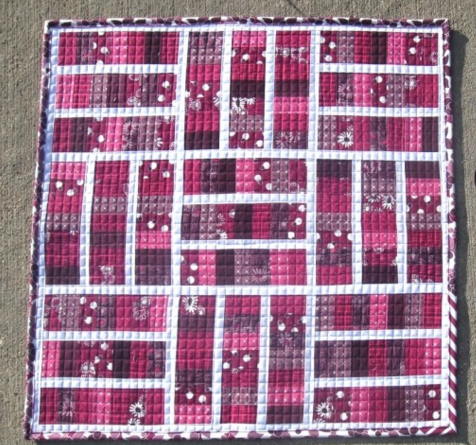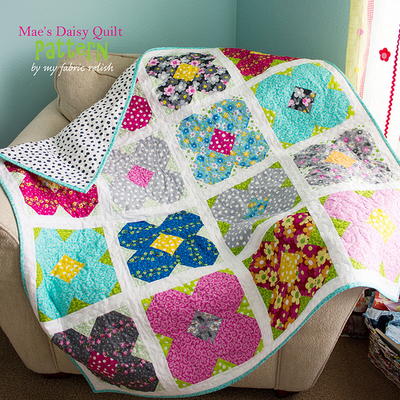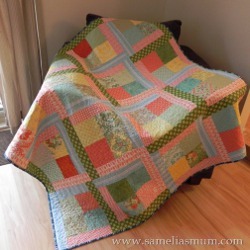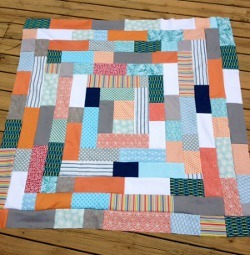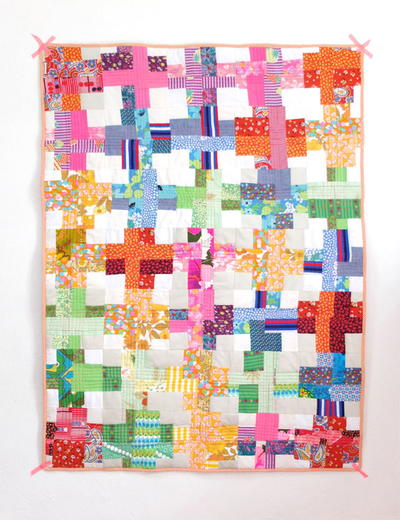Harvest Stars Quilt Pattern

Get the most out of this fall season with a free PDF pattern for Harvest Stars! Do you love the crisp autumn air? Is pumpkin picking a major event in your family? We know that this quilt pattern will be exactly your type!
From the Designer: "This adorable Harvest Stars Quilt Pattern is an easy pattern for even a beginning quilter. Star blocks and nine patch blocks make up the design. Measuring 60" x 60" this quilt is the perfect size to snuggle under. This fun quilt is so charming draped on the back of your couch, the end of your bed, or hanging on a ladder or wall in your home. And, it will match well with any farmhouse décor!"
Find more pretty patterns from our friend Bonnie over at her blog, Lakegirlquilts.
Click Here to Download the PDF Pattern!
Join Our 100,000+ Fans And Sign Up to Receive Your FREE eNewsletter!
General Sewing Directions
- The directions for this quilt are for rotary cutting, machine piecing, machine quilting, and the binding is hand-stitched to the quilt back,
- Accurate cutting and sewing enhances your final product. Pin your pieces together before sewing them to ensure proper seam alignment.
- Sew fabric pieces with right sides together, unless otherwise stated. Use a 1/4" seam allowance. I recommend using a special presser foot with a 1/4" guide if you have one for your machine. This will help you get uniform seams.
- Follow the directions described below as you press the seams. Each row is pressed in the opposite direction of the previous row to help eliminate bulk and allow seams to lay flat.
Fabric Requirements
Yellow/Gold Print Fabric: The total fabric needed is about 1 1/2 yards. However, to achieve the scrappy look of this quilt I suggest using a few different prints. Either raid your stash, or purchase a few new fat quarters.
Light Gray Solid Fabric: 1 1/2 yards
Dark Gray Solid Fabric: 3/4 yard
Cream Solid Fabric: 3/4 yard
Dark Gray Binding Fabric: 1/2 yard
Backing Fabric: You’ll need 2 yards of 108" wide fabric or 4 yards of 42" wide fabric.
Batting: You'll need a twin size (72" x 90") thin cotton batting (like Warm & Natural) to make this quilt.
Cutting Directions
Light Gray Solid Fabric: Cut 13 – 5 3/4" x 5 3/4" and cut 61 – 4 1/2" x 4 1/2"
Dark Gray Solid Fabric: Cut 13 – 5 3/4" x 5 3/4" and cut 12 – 4 1/2" x 4 1/2"
Cream Solid Fabric: Cut 100 – 4 1/2" x 4 1/2"
Binding: Cut 7 - 2 ½” x 42” strips
Backing: If using 108" wide fabric trim to measure 68" x 68". If using 42" wide fabric cut 2 – 2 yard pieces. Trim the salvage edges and sew them together along the 2 yard side using a ½” seam to make a 72" x 80" backing piece. Trim to measure 68" x 68". This size allows the backing to extend 4" beyond all edges of the quilt top.
Batting: Trim to 68" x 68"
Sew the Blocks
Star Block:
- For each star block you'll need to make four yellow/gray quarter square triangle units.
- Use a fine line marker with water soluble ink to draw a diagonal line on the wrong side of two yellow 5 3/4" squares.
- Place one of the yellow squares right sides together with a light gray 5 3/4" square and place the other yellow square right sides together with a dark gray 5 3/4" square. Sew 1/4" on both sides of the diagonal lines. Cut apart on the drawn lines to create four half square triangle units.
- Press each unit open toward the gray fabrics.
vPlace a yellow/light gray half square triangle right sides together with a yellow/dark gray half square triangle so yellow fabrics and gray fabrics are facing each other (you don't want yellow facing yellow and gray facing gray!). Now draw a diagonal line on the wrong side of the half square triangles that are facing up. The diagonal line should run in the opposite direction (perpendicular!) of the seam.
- Sew 1/4" on both sides of the diagonal line.
- Cut each apart on the drawn line to create four yellow/light gray/dark gray quarter square triangle units.
- Trim each quarter square triangle unit to measure 4 1/2" x 4 1/2" square.
- Lay out the four trimmed quarter triangle square units, four 4 1/2" cream squares, and one 4 1/2" light gray square to create the shape of the block. Press the top and bottom rows to the right and press the middle row to the left so the seams will nest, then sew the rows together to form the star block.
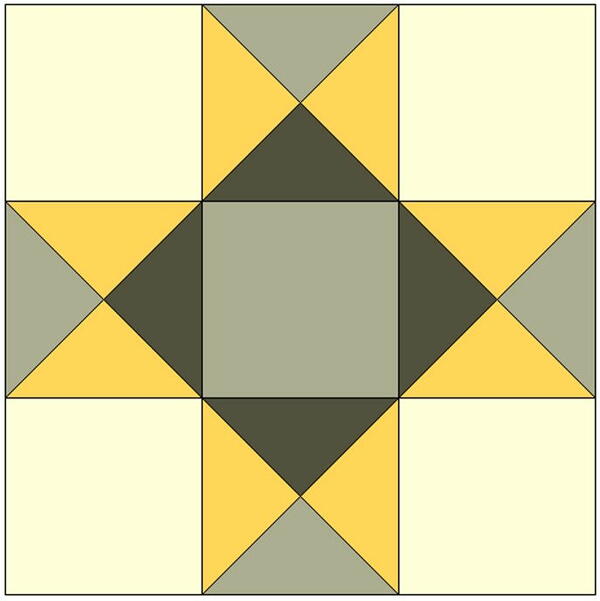
Nine Patch Block:
- Lay out four 4 1/2" cream squares, four 4 1/2" light gray squares, and one 4 1/2" dark gray square to create the shape of the block.
- Sew into rows. Press the top and bottom rows to the right and press the middle row to the left so the seams will nest, then sew the rows together to form the nine patch block.
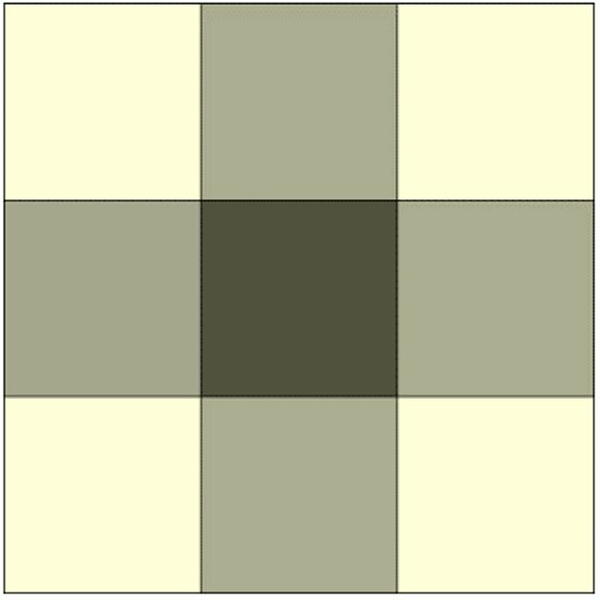
Assemble Quilt Top
- Now that you have the all the blocks sewn it’s time to lay them out and sew them together into rows and then sew the rows together into the quilt top!
- On your design wall or floor, lay out all of the blocks for each row. Arrange the blocks of each row according to the diagram shown above.
- Starting with ROW 1 pin the first and second blocks right sides together. Stitch the blocks together using a 1/4" seam, removing pins as you come to them.
- Repeat until you have all of the blocks sewn to each other for each of ROWS 1 – 5.
- Press the seams of ROWS 1, 3, and 5 to the right. Press the seams of ROWS 2 and 4 to the left. By using this rotating direction of pressed seams, you will have nicely nested seams and less bulk when you sew the ROWS to each other. This method of pressing distributes the bulk, which will make you happy when machine quilting your project! Bulky seams can lead to bumpy quilting patterns, broken thread, and overall unevenness of your quilt top.
- Pin ROW 1 to ROW 2, pinning all nested seams in place. Sew ROWS 1 and 2 together, removing pins as you come to them. Repeat until all rows are sewn to each other, in order, and the quilt top is completed!
- Press the seams connecting each of the rows upward toward ROW 1.
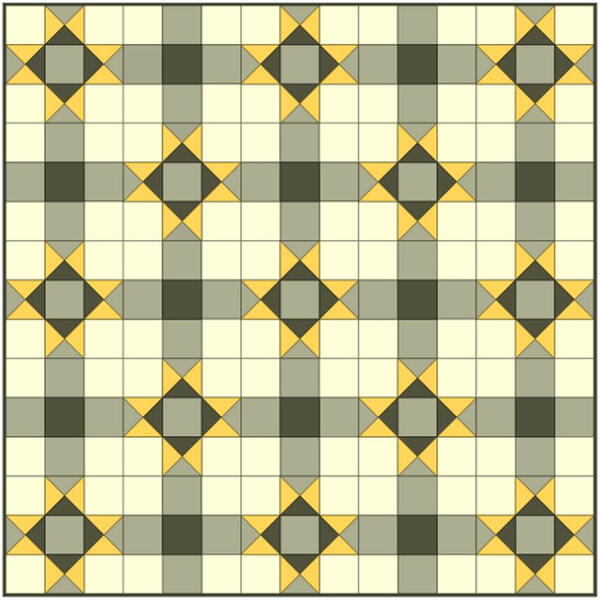
Layering the Top, Batting, and Back
- I refer to layering the quilt as "sandwiching". You need to sandwich the top and back with the batting in the middle.
- Tape the Backing Down – On a hard surface floor, or with two large tables pushed together, use painter’s tape to tape down the backing fabric. As you tape the back down you’ll want to make sure the fabric is smooth, without wrinkles. Also, make sure the right side of the fabric is facing down!
- Add the Batting – Lay the batting on top of the taped-down quilt back, and move your hands across it to smooth it all over. This will get rid of any wrinkles in the batting, and help to adhere it to the backing fabric.
- Place the Quilt Top – Once you have the batting placed on top of the quilt back, center the quilt top over the two bottom layers. Right side facing up, of course! The two bottom layers of the quilt (the back and the batting) should extend about 4" all around the outside edges of the quilt top.
- Move your hands across the quilt top to smooth it all over, and help remove any wrinkles. This will also help adhere the quilt top to the batting a little bit.
- Baste the Layers – You can either spray baste your quilt layers or pin them together with 1 1/2" stainless pins. Place pins around the entire quilt every 4-5 inches so the three layers don’t move around when you’re machine quilting this project. Again, make sure all wrinkles are smoothed out. Adjust basting if needed to remove any wrinkles.
“Quilting” the Quilt
Use whatever free-motion stitch you'd like, I like to use a simple meandering design but you could also quilt in straight lines! You’ll need a darning foot to free-motion quilt on your domestic sewing machine, and you’ll need to either be able to lower the feed dogs on the machine or place a special cover over them. If you’re using a straight stitch to machine quilt you’ll need a walking foot to allow the layers to move smoothly through the sewing machine without bunching up. You could also hand-quilt or tie the quilt to secure the layers together.
Binding the Quilt
When you’ve finished securing the layers together, it’s time to bind your quilt!
Prepare the Binding – Fold each of the cut binding strips in half end to end. Use the 45° line on your plastic ruler to trim the ends at a 45° angle.
- When you open the strips the angles on the ends will be facing in opposite directions.
- Place the ends of two strips perpendicular, right sides together, and sew 1/4" seam.
- Repeat to join all strips into one long binding strip. Press in half lengthwise, right sides facing out.
Sew the Binding to the Quilt – Begin to sew the raw edge of the binding to the quilt by pinning it along one side. Be careful to sew the raw edge of the binding strip to the quilt, not the folded edge! I usually start sewing the binding strip in the middle of the quilt side that I’m starting with. Start sewing about 12" in from the end of the binding strip, leaving a hanging "tail" on the binding. You’ll sew this to the other end of the binding strip when you finish sewing all along the sides of the quilt.
- Stop sewing on the first side 1/4" from the corner, use a pin to mark this location and sew right up to it. Backstitch a bit, and cut your thread but DON’T cut the binding strip.
Making the Mitered Corner – Now, remove the quilt and binding strip from your machine and fold the binding strip straight up beyond the edge of the quilt so it’s perpendicular from the side you were just sewing on.
- Fold the binding strip back down on itself and match it to the edge of the quilt you just sewed it to, and the next edge of the quilt you’re about to sew it to. Pin this fold in place, and pin the binding strip to this edge of the quilt and continue to sew it, again stopping 1/4" from the next corner and repeating the folding process described above. Continue in this manner until you are on the last side of the quilt, the side you started on.
Connecting the Ends of the Binding – Stop stitching about 14" – 16" from where you started. Backstitch and cut the thread (but not the binding strip, not yet!), remove the quilt and binding strip from the machine.
- You now have two "tails" of the binding strip, tail #1 from where you started stitching it to the quilt and tail #2 from where you ended.
- You’ll need to join these tails together so that you have a continuous binding strip to finish sewing down to the quilt. Follow the steps below to join the tails!
- STEP 1 Lay tail #1 of the binding strip along the unsewn edge of the quilt. Trim it at a 90° angle about half way between this unsewn edge.
- STEP 2 Lay tail #2 of the binding strip over tail #1 along the unsewn edge of the quilt. Measure 2 1/2" beyond the trimmed straight edge of tail #1. Mark this 2 1/2" measurement with a pin or pencil, and trim the tail #2 at a 90° angle also. The two trimmed binding strip tails should overlap by 2 1/2".
- STEP 3 Unfold the two tails so they lay flat. Pin the two tails together perpendicular to each other (right sides together). Use a fine pencil to draw a diagonal line from the corner of tail #2 to the opposite side, as shown here.
- Sew along the drawn diagonal line. Trim the outside corner 1/4" from the seam and finger press the seam open. Fold binding strip in half again. The continuous binding strip should now lay flat along the unsewn edge of the quilt. Finish sewing the binding strip to the quilt.
Trim the Batting and Back – Trim the batting and quilt back to 1/4" from the edge of the quilt top. I use a ruler and a rotary cutter to accomplish this task. Work carefully, so you don’t cut into your quilted project!
Hand-Stitch the Folded Binding Edge to the Quilt Back – Hand-stitch the folded edge of the binding strip to the back of the quilt. When you get to the corner, carefully turn the corner right-side out to make a crisp, mitered corner. I tack a few stitches up the corner to hold it in place, and then continue stitching along all sides and corners until…VOILA! Your quilt is complete! Make sure to add a label to the back!!
Are you going to make your own Harvest Star? Let us know in the comments section below.
Read NextMae's Daisy Lap Quilt Pattern

